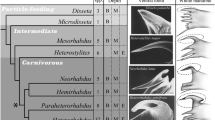Abstract
High-resolution videos, scanning electron microscopy and histology were used to study the feeding mechanism of myodocopid ostracods from the Pacific Coast of Japan, as exemplified by Vargula hilgendorfii (Müller, 1890) and a few other cypridinid species. Ostracods observed in the laboratory were attracted to a wide spectrum of natural food sources, behaving as predators of living prey (e.g. polychaete annelids), as opportunistic scavengers on dead animals (e.g. annelids, fishes, squid), and also consuming artificial food. Food sources may be detected by chemoreception. The fourth limb (endopodites with strong sclerotized setae) and the furcal lamellae (claws with teeth) act in coordination to abrade and eventually tear open the protective integument of living/dead prey such as annelids. The mandibular palps are used mainly to hold the food. Food sections and soft-body contents are transferred to the mouth by the fourth limb (endopodial “rake”) and fifth limb (exopodite with pectinate setae) and are passed to the oesophagus by the endites (mandibles, fourth and fifth limbs). Food is subsequently pumped up to the stomach by peristaltic contractions of the oesophagus (ring muscles) and stored in the stomach pouch. The upper lip of bioluminescent (V. hilgendorfii) and non-bioluminescent species of Cypridinidae often contact food, suggesting that some of the glands housed in this organ may emit digestive enzymes prior to ingestion. Ostracods are able to ingest massive quantities of food within a few minutes and to survive starvation for several weeks. In V. hilgendorfii, the midgut is a huge sac-like organ with no partition and is lined with a single layer of columnar epithelial cells. No differentiated hepatopancreas is present. The cypridinid produces a single faecal pellet wrapped in a thin reticulated, peritrophic membrane. Myodocopid ostracods exhibit a wide range of feeding strategies (detritus-feeding, comb-feeding, scavenging, predation, ectoparasitism) in both benthic and pelagic niches, and constitute a substantial source of food for many zooplankters. Adaptation of cypridinids to scavenging/predation is reflected in the morphology of their furcae, mandibles, fourth and fifth limbs, and their digestive system. Palaeontological data suggest that early Triassic cypridinids and possible late Ordovician myodocopids may have been carnivorous scavengers feeding on carcasses of cephalopods (ammonoids or orthoconic nautiloids), thus playing the same role of “recyclers” as modern representatives of the group.
Similar content being viewed by others
Author information
Authors and Affiliations
Additional information
Received: 2 January 1998 / Accepted: 23 July 1998
Rights and permissions
About this article
Cite this article
Vannier, J., Abe, K. & Ikuta, K. Feeding in myodocopid ostracods: functional morphology and laboratory observations from videos. Marine Biology 132, 391–408 (1998). https://doi.org/10.1007/s002270050406
Issue Date:
DOI: https://doi.org/10.1007/s002270050406




